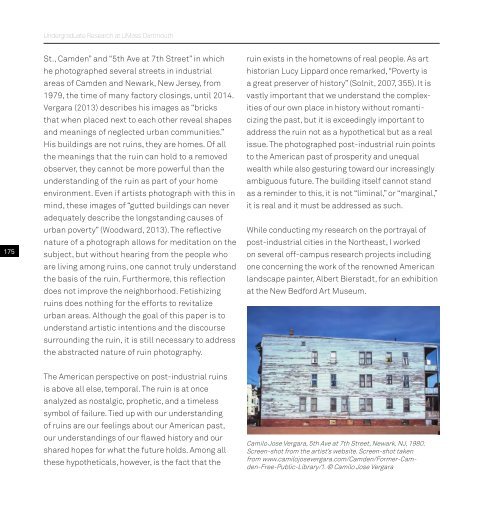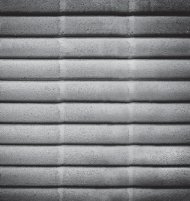Undergrad_Book_16-18_Pge_View_Print_no print marks_compressed
Create successful ePaper yourself
Turn your PDF publications into a flip-book with our unique Google optimized e-Paper software.
<strong>Undergrad</strong>uate Research at UMass Dartmouth<br />
175<br />
St., Camden” and “5th Ave at 7th Street” in which<br />
he photographed several streets in industrial<br />
areas of Camden and Newark, New Jersey, from<br />
1979, the time of many factory closings, until 2014.<br />
Vergara (2013) describes his images as “bricks<br />
that when placed next to each other reveal shapes<br />
and meanings of neglected urban communities.”<br />
His buildings are <strong>no</strong>t ruins, they are homes. Of all<br />
the meanings that the ruin can hold to a removed<br />
observer, they can<strong>no</strong>t be more powerful than the<br />
understanding of the ruin as part of your home<br />
environment. Even if artists photograph with this in<br />
mind, these images of “gutted buildings can never<br />
adequately describe the longstanding causes of<br />
urban poverty” (Woodward, 2013). The reflective<br />
nature of a photograph allows for meditation on the<br />
subject, but without hearing from the people who<br />
are living among ruins, one can<strong>no</strong>t truly understand<br />
the basis of the ruin. Furthermore, this reflection<br />
does <strong>no</strong>t improve the neighborhood. Fetishizing<br />
ruins does <strong>no</strong>thing for the efforts to revitalize<br />
urban areas. Although the goal of this paper is to<br />
understand artistic intentions and the discourse<br />
surrounding the ruin, it is still necessary to address<br />
the abstracted nature of ruin photography.<br />
ruin exists in the hometowns of real people. As art<br />
historian Lucy Lippard once remarked, “Poverty is<br />
a great preserver of history” (Solnit, 2007, 355). It is<br />
vastly important that we understand the complexities<br />
of our own place in history without romanticizing<br />
the past, but it is exceedingly important to<br />
address the ruin <strong>no</strong>t as a hypothetical but as a real<br />
issue. The photographed post-industrial ruin points<br />
to the American past of prosperity and unequal<br />
wealth while also gesturing toward our increasingly<br />
ambiguous future. The building itself can<strong>no</strong>t stand<br />
as a reminder to this, it is <strong>no</strong>t “liminal,” or “marginal,”<br />
it is real and it must be addressed as such.<br />
While conducting my research on the portrayal of<br />
post-industrial cities in the Northeast, I worked<br />
on several off-campus research projects including<br />
one concerning the work of the re<strong>no</strong>wned American<br />
landscape painter, Albert Bierstadt, for an exhibition<br />
at the New Bedford Art Museum.<br />
The American perspective on post-industrial ruins<br />
is above all else, temporal. The ruin is at once<br />
analyzed as <strong>no</strong>stalgic, prophetic, and a timeless<br />
symbol of failure. Tied up with our understanding<br />
of ruins are our feelings about our American past,<br />
our understandings of our flawed history and our<br />
shared hopes for what the future holds. Among all<br />
these hypotheticals, however, is the fact that the<br />
Camilo Jose Vergara, 5th Ave at 7th Street, Newark. NJ, 1980.<br />
Screen-shot from the artist’s website. Screen-shot taken<br />
from www.camilojosevergara.com/Camden/Former-Camden-Free-Public-Library/1.<br />
© Camilo Jose Vergara



